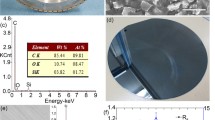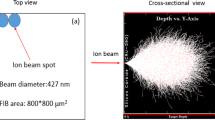Abstract
Nanoindentation was used to examine the impact of impurities and grain boundaries on the mechanical properties of a “model” (110)/(100) grain boundary (GB) interface prepared using direct silicon bonding via the hybrid orientation technique of (110) and (100) p-type silicon wafers. Remarkable differences were found between the mechanical behavior of Fe- and Cu-contaminated samples. The direct silicon bonded wafers contaminated with either Fe or Cu showed opposite effects on mechanical properties, with Fe enhancing the silicon hardness, while Cu contamination induces a gradual weakening. High-resolution transmission electron microscopy was used to verify that the abrupt hardness changes observed during increasing nanoindentation loading is attributed to local deformation induced by the GB interface, Cu precipitate colony induced dislocations, and the abrupt crystallographic orientation change across the GB. The resulting dislocation loop generation facilitated the deformation process during nanoindentation and therefore softened the material.





Similar content being viewed by others
References
I. Yonenaga and K. Sumino: Mechanical strength of silicon crystals as a function of the oxygen concentration. J. Appl. Phys. 56, 2346 (1984).
A. Spitznagel, R.G. Seidensticker, S.Y. Lien, and R.H. Hopkins, in: Oxygen, Carbon, Hydrogen, and Nitrogen in Silicon, Mater. Res. Soc. Symp. Proc., Eds. J.C. Mikkelsen, S.J. Pearton, J.W. Corbett, and S.J. Pennycook. Pennington, NJ, 383 (1986).
F. Shimura and R.S. Hockett: Nitrogen effect on oxygen precipitation in Czochralski silicon. Appl. Phys. Lett. 48, 224 (1986).
D. Ge, A.M. Minor, E.A. Stach, and J.W. Morris Jr.: Size effects in the nanoindentation of silicon at ambient temperature. Phil Mag. 86, 4069 (2006).
K. Sumino, I. Yonenaga, M. Imai, and T. Abe: Effects of nitrogen on dislocation behavior and mechanical strength in silicon crystals. J. Appl. Phys. 54, 5016 (1983).
S.M. Hu and W.J. Patrick: Effect of oxygen on dislocation movement in silicon. J. Appl. Phys. 46, 1869 (1975).
J.D. Murphy, A. Giannattasio, C.R. Alpass, S. Senkader, R.J. Falster, and P.R. Wilshaw: The influence of nitrogen on dislocation locking in float-zone silicon. Solid State Phenom. 108, 139 (2005).
M. Yang, W.C. Chan, K.K. Chan, L. Shi, D.M. Fried, J.H. Stathis, A.I. Chou, E. Gusev, J.A. Ott, L.E. Burns, M.V. Fischetti, and M. Ieong: Hybrid-orientation technology (HOT): Opportunities and challenges. IEEE Trans. Elec. Dev., 53, 965 (2006).
G.M. Pharr: Measurements of mechanical properties by ultra-low load indentation. Mater. Sci. Eng. A253, 151 (1998).
W.C. Oliver and G.M. Pharr: An improved technique for determining hardness and elastic modulus using load and displacement sensing indentation experiments. J. Mater. Res. 7, 1564 (1992).
M.F. Doerner and W.D. Nix: A method for interpreting the data from depth-sensing indentation instruments. J. Mater. Res. 1, 601 (1986).
I. Chasiotis, S.W. Cho, and K. Jonnalagadda: Fracture toughness and subcritical crack growth in polycrystalline silicon. Trans. ASME 73, 714 (2006).
B.R. Lawn, D.B. Marshall, G.R. Anstis, and T.P. Dabbs: Fatigue analysis of brittle materials using indentation flaws. J. Mater. Sci. 16, 2846 (1981).
B. Lawn and R. Wilshaw: Indentation fracture: Principles and applications. J. Mater. Sci. 10, 1049 (1975).
W.C. Oliver and G.M. Pharr: Measurement of hardness and elastic modulus by instrumented indentation: Advances in understanding and refinements to methodology. J. Mater. Res. 19, 3 (2004).
Y. Cheng and C. Cheng: Further analysis of indentation loading curves: Effects of tip rounding on mechanical property measurements. J. Mater. Res. 13, 1059 (1998).
G. Rozgonyi, J. Lu, M. Wagener, X. Yu, Y. Park, and K. Youssef: Enhancing Silicon PV Materials Research via IC Wafer Engineering Defect Science Experiences and Industry/University Consortia: SiWEDS to SiSoC. The 5th Inter. Sympo. Adv. Sci. Tech. Si Mater. Nov. (2008), 323, Hawaii, USA.
F. Ebrahimi and L. Kalwani: Fracture anisotropy in silicon single crystal. Mater. Sci. Eng. A268, 116 (1999).
B.R. Lawn and M.V. Swain: Microfracture beneath point indentations in brittle solids. J. Mater. Sci. 10, 113 (1975).
O. Shikimaka and D. Grabco: Deformation created by Berkovich and Vickers indenters and its influence on surface morphology of indentations for LiF and CaF2 single crystals. J. Phys. D: Appl. Phys. 41, 074012 (2008).
J. Chen and S.J. Bull: On the relationship between plastic zone radius and maximum depth during nanoindentation. Surf. Coat. Tech. 201, 4289 (2006).
J. Jang, M.J. Lance, S. Wen, T.Y. Tsui, and G.M. Pharr: Indentation-induced phase transformations in silicon: influences of load, rate and indenter angle on the transformation behavior. Acta Mater. 53, 1759 (2005).
V. Domnich, Y. Gogotsi, and S. Dub: Effect of phase transformations on the shape of the unloading curve in the nanoindentation of silicon. Appl. Phys. Lett. 76, 2214 (2000).
E.R. Weber: Transition metals in silicon. Appl. Phys. A30, 1 (1983).
M. Seibt, M. Griess, A.A. Istratov, H. Hedemann, A. Sattler, and W. Schroter: Formation and properties of copper silicide precipitates in silicon. Phys. Stat. Sol., 166, 177 (1998).
W.C. Dash: Copper precipitation on dislocations in silicon. J. Appl. Phys. 27, 1193 (1956).
H. Gottschalk: Precipitation of copper silicide on glide dislocations in silicon at low temperature. Phys. Stat. Sol. 137, 447 (1993).
Z. Xi, D. Yang, J. Chen, J. Xu, Y. Ji, D. Que, and H. Moeller: Influence of copper precipitation on oxygen precipitation in Czochralski silicon. Semicond. Sci. Tech. 19, 299 (2004).
A. Broniatowski and C. Haut: The electronic properties of copper-decorated twinned boundaries in silicon. Phil. Mag. Lett. 62, 407 (1990).
M. Seibt: On the role of stacking-faults in copper precipitation in silicon. Sol. Stat. Phenom., 19, 45 (1991).
Acknowledgments
The authors would like to thank Mike Seacrist of MEMC Electronic Materials, Inc. for providing the DSB wafers. Financial support by the National Science Foundation and Silicon Solar Consortium is gratefully acknowledged.
Author information
Authors and Affiliations
Corresponding author
Rights and permissions
About this article
Cite this article
Youssef, K., Yu, X., Seacrist, M. et al. Understanding the effect of impurities and grain boundaries on mechanical behavior of Si via nanoindentation of (110)/(100) direct Si bonded wafers. Journal of Materials Research 27, 349–355 (2012). https://doi.org/10.1557/jmr.2011.265
Received:
Accepted:
Published:
Issue Date:
DOI: https://doi.org/10.1557/jmr.2011.265




